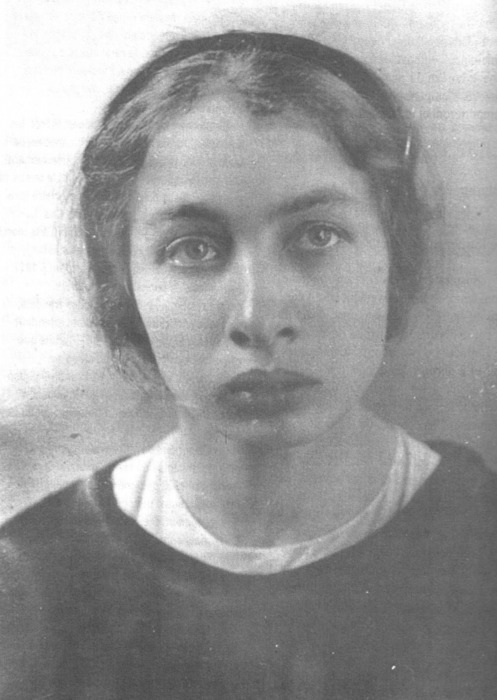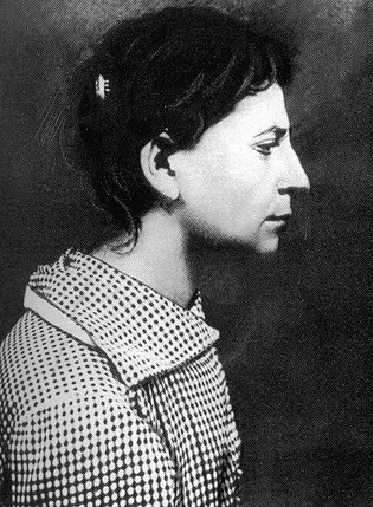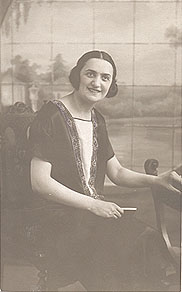<Back to Index>
- Humanist Scholar Thomas Platter the Elder, 1499
- Sculptor Fritz Klimsch, 1870
- Russian Revolutionary Fanny Yefimovna Kaplan, 1890
PAGE SPONSOR



Fanny Yefimovna Kaplan (Russian: Фа́нни Ефи́мовна Капла́н; February 10, 1890 – September 3, 1918), also known as Fanya Kaplan and as Dora Kaplan), was a Russian political revolutionary and an attempted assassin of Vladimir Lenin.
There is some confusion as to Kaplan's birth name. Vera Figner, in her memoirs, At Women's Katorga, gives the name Feiga Khaimovna Roytblat - Kaplan (Фейга Хаимовна Ройтблат - Каплан). Other sources give her original family name as Ройтман (transliterated from Russian as Roytman, which corresponds to the common German / Yiddish name Reutemann). [Actually, given the results of a certain vowel shift in Yiddish, "Roytman" would be the Yiddish word with the English meaning "Redman", whose German equivalent would be "Rothman".]
Kaplan was born into a Jewish family, one of seven children. She became a political revolutionary at an early age and joined a socialist group, the Socialist Revolutionaries (Esers). In 1906, Kaplan was arrested in Kiev over her involvement in a terrorist bomb plot, and committed for life to the katorga system (a form of forced labour). She served in the Maltsev and Akatuy prisons of Nerchinsk katorga, Siberia, where she lost her sight (partially restored later). She was kept in the Maltzevskaya prison, where she was severely caned with birches (розги) on her bare body as disciplinary corporal punishment. Fully undressed corporal punishment was not usual for political prisoners at that time. She was released on March 3, 1917, after the February Revolution overthrew the imperial government. As a result of her imprisonment, Kaplan suffered from continuous headaches and periods of blindness.
Kaplan became disillusioned with Lenin as a result of the conflict between the Socialist Revolutionaries and the Bolshevik party. The Bolsheviks had strong support in the soviets; however, in elections to a competing body, the Constituent Assembly, the Bolsheviks failed to win a majority in the November 1917 elections and a Socialist Revolutionary was elected President in January 1918. The Bolsheviks, favoring soviets, ordered the Constituent Assembly to be dissolved. By August 1918 conflicts between the Bolsheviks and their political opponents had led to the banning of most other influential parties - most recently, of the Left Socialist Revolutionaries, who had been the Bolsheviks' principal coalition partner for some time, but had organized a revolt in July because of their opposition to the Brest - Litovsk Peace Treaty. Kaplan decided to assassinate Lenin.
According to official accounts, on August 30, Lenin was speaking at a Moscow factory called "Hammer and Sickle". As Lenin left the building and before he entered his car, Kaplan called out to him. When Lenin turned towards her, she fired three shots. One passed through Lenin's coat, the other two hit him in the left shoulder and jaw.
Lenin was taken back to his living quarters at the Kremlin. He feared there might be other plotters planning to kill him and refused to leave the security of the Kremlin to seek medical attention. Doctors were brought in to treat him but were unable to remove the bullets outside of a hospital. Despite the severity of his injuries, Lenin survived. However, Lenin's health never fully recovered from the attack and it is believed the shooting contributed to the strokes that incapacitated and later killed him.
Kaplan was taken into custody and interrogated by the Cheka. She made the following statement: My name is Fanya Kaplan. Today I shot at Lenin. I did it on my own. I will not say from whom I obtained my revolver. I will give no details. I had resolved to kill Lenin long ago. I consider him a traitor to the Revolution. I was exiled to Akatui for participating in an assassination attempt against a Tsarist official in Kyiv. I spent 11 years at hard labour. After the Revolution, I was freed. I favoured the Constituent Assembly and am still for it. When it became clear that Kaplan would not implicate any accomplices, she was shot dead on September 3, 1918.
In recent years the actual role of Kaplan in the assassination attempt has been questioned by several historians (amongst them Arkadi Vaksberg and Donald Rayfield). Vaksberg says it was Lidia Konopleva, another SR, who was the culprit: believing it would be all too comforting that Lenin narrowly avoided being assassinated by a woman whose personality is so far from the stereotype of a national hero. In particular, it is suggested that she was working on behalf of others and after her arrest assumed sole responsibility. The main argument put forth in this and other versions is her near - blindness. Another argument points to the contradiction between the official Soviet account (Kaplan was immediately seized by angry workers who witnessed the event) and official documents, in particular a radiogram by Yakov Peters which talks about an arrest of several suspects.
In the official announcement Kaplan was declared a Right Eser. On the same day, Moisei Uritsky, People's Commissar for Internal Affairs in the Northern Region and head of the Cheka in Petrograd, was assassinated. While the Cheka did not find any evidence linking the two events, their co-occurrence appeared significant in the overall context of the intensifying civil war. The Bolshevik reaction was an abrupt escalation in the persecution of their opponents.
An official decree for Red Terror was issued only hours after the Kaplan shooting, calling for "a merciless mass terror against all the enemies of the revolution." In the next few months, about 800 Right SRs and other political opponents of Bolsheviks were executed without trial. During the first year the scope of Red Terror expanded significantly and the number of executions grew into the thousands. Some historians consider this to be a harbinger of the Great Purge, but others consider that the purges of the 1930s and the Great Purge were not only quantitatively different from the Red Terror under Lenin, but also took place for very different reasons and in a very different context.
Fanny Kaplan was always presented by the Soviet propaganda as a complete monster. Her reputation has not been rehabilitated completely even after the fall of the Communist regime in Russia, but in popular opinion, the personality of Fanny Kaplan is often considered as one of a 'woman of mystery.' Several writers included Kaplan as characters in their plays ('Fanny Kaplan' by Venedikt Erofeev; 'Kill me, o my beloved!' by Elena Isaeva).